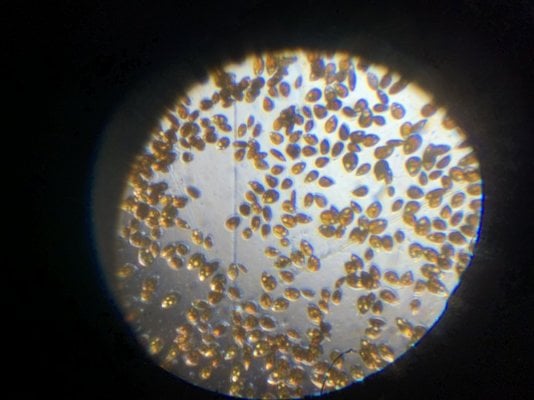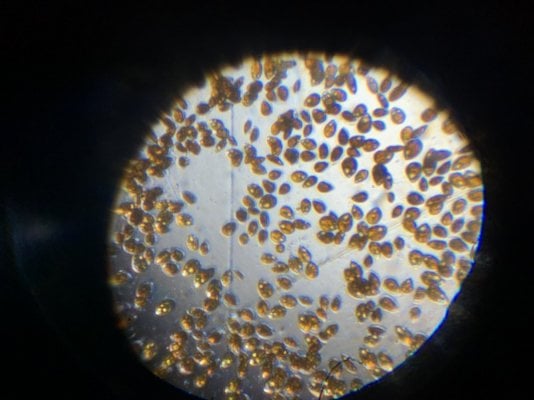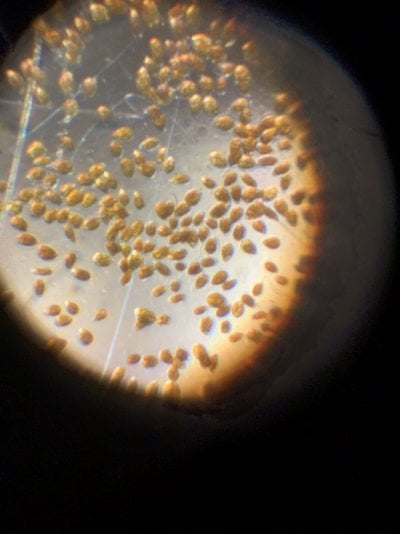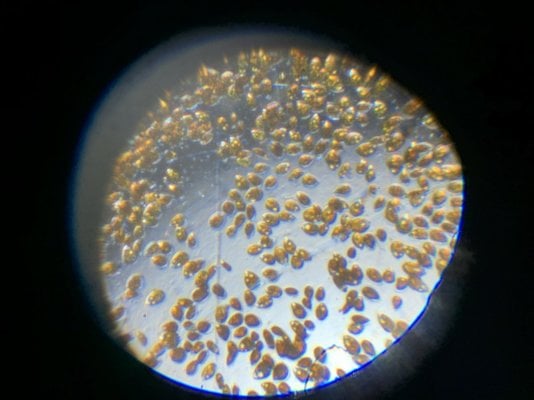Does this mean I need two different phosphate tests?Dino outbreak will sure happen with 0 po4 and 0 Po3
Navigation
Install the app
How to install the app on iOS
Follow along with the video below to see how to install our site as a web app on your home screen.
Note: This feature may not be available in some browsers.
More options
You are using an out of date browser. It may not display this or other websites correctly.
You should upgrade or use an alternative browser.
You should upgrade or use an alternative browser.
Dinoflagellates – Are You Tired Of Battling Altogether?
- Thread starter mcarroll
- Start date
- Tagged users None
Hanna Phosphorus ULR OR Hanna Phosphate ULR is all you need. And the simple formula to translate Phosphorus to PO4.Does this mean I need two different phosphate tests?
Share a good video of movement or solve your self with the videos linked here.It moves like it’s tethered to a string, like the planets around the sun. Very round and not almond shaped from what I see. I am not home now but will try to get better pictures tomorrow. This red stuff starts to get real bubbly the longer lights are on, and in the morning there’s hardly any air bubbles at all This red stuff will cover most of the rock (some bare spots) if left unchecked. I try to siphon out by filtering through a bag letting water drain back into sump.

Dinoflagellate Identification Guide
I've had this laying around for a while. Had some recent interest, so I tweaked it a bit and am posting it. Not really about cures just ID pictures, videos, and a few short facts. Hope it can be helpful.
 www.reef2reef.com
www.reef2reef.com
So I'm curious were these ciliates potentially taking out your dino population (ie did it decrease)? Or do you think they were just eating them haphazardly?Ciliate eating prorocentrum dinoflagellates!
I also found several kinds of ciliates (though not the one you posted) eating dinos in my systems. And played around with culturing them but that was a total flop.
Hard to find a food source to grow ciliates that eat dinos. And precise identification is a nightmare.
How old is this system? Looks kinda new. If so, this could just be an uglies phase that the tank will grow out of. UV would help. Some nutrients too.Based on the movement in the video I would say I have ostreopsis. I’ve been dosing phytoplankton, will my uv negate any benefit from phyto?
As to phyto, the generally recommendation is to stop dosing until the dinos have abated as they are brilliant consumers of it.
I think they meant NO3 not po3Does this mean I need two different phosphate tests?
- Joined
- May 22, 2016
- Messages
- 6,970
- Reaction score
- 10,747
I was doing a test where I got new sand, and fed it and let it colonize with algae/bacteria/etc. Then when it looked well-occupied by other organisms, I started adding some dinos (ostreopsis) to see if the very live sand would suppress them. The dinos did not take hold, and under microscope observation of the parts of the sand that I placed dinos, I found a large population of a kind of worm-like ciliate that had ingested the ostreopsis.So I'm curious were these ciliates potentially taking out your dino population (ie did it decrease)? Or do you think they were just eating them haphazardly?
(video)
Taking a beaker of the ciliate population and increasing the dose of ostreopsis, the ciliates died.
I concluded that even toxic dino predators need a mostly non-dino diet, as nothing grows well on a pure diet of toxic dinos. So how would you culture these? You'd need something that was nearly dino-sized, and similar in habit but not toxic. Large diatoms maybe? Commercial phytos are far too small and end up growing totally different population of ciliates.
The project was beyond my skill-set.
System just turned 2 years old. Thanks for the replies, I’ll ease back the phyto and see how the uv does. Won’t have a phosphate test until end of month. Amazon prime 2 day delivery my foot.How old is this system? Looks kinda new. If so, this could just be an uglies phase that the tank will grow out of. UV would help. Some nutrients too.
As to phyto, the generally recommendation is to stop dosing until the dinos have abated as they are brilliant consumers of it.
- Joined
- Dec 4, 2018
- Messages
- 6
- Reaction score
- 0
Hi Eveyrone,
I am new here and lucky for me I am posting my first post here. I really just need help identifying the type of Dinos that I have.
Background information:
Tank is 90 gallon with ~30 gallon sump, started August 1st 2020. Initially moved over my 2 clowns from an existing tank, and over time added a pair of grammas, a flame hawk, a rainfords goby and yellow tang by December. Unfortunately, I didn't qt (lesson learned) so I am currently dealing with ich. All fish are removed and about 2.5 weeks in to treatment in qt tanks. Now the DT is fallow and even when fish were in it I had trouble getting any detectable nutrients. I started dosing neonitro to get Nitrates to detectable levels and kept them ~5 PPM. I was not thinking when I did this, and did not simultaneously dose neophos for at least a couple weeks, so I had bottomed out phosphate. I began dosing neophos and currently am maintaining level around .1 but it was too late. I had already started to see brown stringy algae on the sand. I also saw some red algae and it appeared to be cyano. On Sunday 1/17 I did 15 gallon water change and manually removed all the dinos in the sand. The next day they were back and worse than ever because my powerhead was soaking in overnight to be cleaned so the flow was much lower in the tank than usual. I noticed there was still cyano everywhere so I dosed chemiclean before going to work. When I retuned the dinos had longer strings and had begun to migrate to lower flow areas of the rocks. I have attached photos of the tank and the algae as well as the microscope picture and video I was able to capture.



I am new here and lucky for me I am posting my first post here. I really just need help identifying the type of Dinos that I have.
Background information:
Tank is 90 gallon with ~30 gallon sump, started August 1st 2020. Initially moved over my 2 clowns from an existing tank, and over time added a pair of grammas, a flame hawk, a rainfords goby and yellow tang by December. Unfortunately, I didn't qt (lesson learned) so I am currently dealing with ich. All fish are removed and about 2.5 weeks in to treatment in qt tanks. Now the DT is fallow and even when fish were in it I had trouble getting any detectable nutrients. I started dosing neonitro to get Nitrates to detectable levels and kept them ~5 PPM. I was not thinking when I did this, and did not simultaneously dose neophos for at least a couple weeks, so I had bottomed out phosphate. I began dosing neophos and currently am maintaining level around .1 but it was too late. I had already started to see brown stringy algae on the sand. I also saw some red algae and it appeared to be cyano. On Sunday 1/17 I did 15 gallon water change and manually removed all the dinos in the sand. The next day they were back and worse than ever because my powerhead was soaking in overnight to be cleaned so the flow was much lower in the tank than usual. I noticed there was still cyano everywhere so I dosed chemiclean before going to work. When I retuned the dinos had longer strings and had begun to migrate to lower flow areas of the rocks. I have attached photos of the tank and the algae as well as the microscope picture and video I was able to capture.
Going to need to zoom in a bit more dude!Hi Eveyrone,
I am new here and lucky for me I am posting my first post here. I really just need help identifying the type of Dinos that I have.
Background information:
Tank is 90 gallon with ~30 gallon sump, started August 1st 2020. Initially moved over my 2 clowns from an existing tank, and over time added a pair of grammas, a flame hawk, a rainfords goby and yellow tang by December. Unfortunately, I didn't qt (lesson learned) so I am currently dealing with ich. All fish are removed and about 2.5 weeks in to treatment in qt tanks. Now the DT is fallow and even when fish were in it I had trouble getting any detectable nutrients. I started dosing neonitro to get Nitrates to detectable levels and kept them ~5 PPM. I was not thinking when I did this, and did not simultaneously dose neophos for at least a couple weeks, so I had bottomed out phosphate. I began dosing neophos and currently am maintaining level around .1 but it was too late. I had already started to see brown stringy algae on the sand. I also saw some red algae and it appeared to be cyano. On Sunday 1/17 I did 15 gallon water change and manually removed all the dinos in the sand. The next day they were back and worse than ever because my powerhead was soaking in overnight to be cleaned so the flow was much lower in the tank than usual. I noticed there was still cyano everywhere so I dosed chemiclean before going to work. When I retuned the dinos had longer strings and had begun to migrate to lower flow areas of the rocks. I have attached photos of the tank and the algae as well as the microscope picture and video I was able to capture.



- Joined
- Dec 4, 2018
- Messages
- 6
- Reaction score
- 0
Sorry About that. I have attached videos at 400x and photos at 250x and 1000x hopefully will be better for identifying the dinos.Going to need to zoom in a bit more dude!
Double post.
Sorry About that. I have attached videos at 400x and photos at 250x and 1000x hopefully will be better for identifying the dinos.


Looks like prorocentrum.
Does anyone know of any tests that have been done to see what spectrum of light encourages the fastest growth of dinoflagellates?
I'm noticing a much higher growth rate under heavy blues than a whiter spectrum
I'm noticing a much higher growth rate under heavy blues than a whiter spectrum
- Joined
- May 22, 2016
- Messages
- 6,970
- Reaction score
- 10,747
nuisance Dinoflagellates contain the same photopigments as the symbiotic dinos in corals - in quite similar ratios. Dominated by Chlorophyll A, Chl C, and peridinin, they absorb useful light everywhere from <400 to 550nm (near UV through green).Does anyone know of any tests that have been done to see what spectrum of light encourages the fastest growth of dinoflagellates?
I'm noticing a much higher growth rate under heavy blues than a whiter spectrum
"blues only" is only a decent measure against green algae and it just lowers their efficiency a little bit.
So they don't absorb green through to red?
Hi im french , i have change all of my rock in my reefer 170 tu ring since 5 years ,for marco since 2 month ago ( invasion of cervera , pachy ect...) and now i have à invasion of dino i think but which ?
i post photo , and also can you tell me the best solution ? I have tried 4 dose of DINO X FAUNA MARIN and at the day 8 so 4 doses there were even more so i decided to stop it ... maybe to quickly?
i have a uv aquamedic hélix 2.0 in stock but not use yet and i bottle of vibrant new
look a the picture and vidéo , Ty
i post photo , and also can you tell me the best solution ? I have tried 4 dose of DINO X FAUNA MARIN and at the day 8 so 4 doses there were even more so i decided to stop it ... maybe to quickly?
i have a uv aquamedic hélix 2.0 in stock but not use yet and i bottle of vibrant new
look a the picture and vidéo , Ty
Attachments
What else am I looking at here other than the obvious LC Amphidinium?

Hi im french , i have change all of my rock in my reefer 170 tu ring since 5 years ,for marco since 2 month ago ( invasion of cervera , pachy ect...) and now i have à invasion of dino i think but which ?
i post photo , and also can you tell me the best solution ? I have tried 4 dose of DINO X FAUNA MARIN and at the day 8 so 4 doses there were even more so i decided to stop it ... maybe to quickly?
i have a uv aquamedic hélix 2.0 in stock but not use yet and i bottle of vibrant new
look a the picture and vidéo , Ty
This is ostreopsis.
UV is necessary. One watt per three gallons. Run the flow really slow. Run it to/from the display itself.
No Vibrant, no dino-x, no phyto, no amino acids
Dose up NO3 and PO4. Neonitro and NeoPhos are good. Get to 10 and .1 respectively.
Run granular activated carbon as this species is quite toxic.
Similar threads
- Replies
- 43
- Views
- 544
- Replies
- 1
- Views
- 89
- Replies
- 4
- Views
- 251























